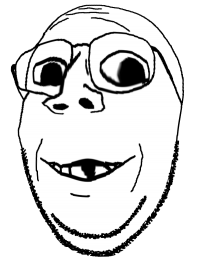Main Page/Featured Gem: Difference between revisions
From Soyjak Wiki, The Free Soycyclopedia
Jump to navigationJump to search
BritishScum (talk | contribs) (no you dont) Tag: Manual revert |
No edit summary |
||
| (37 intermediate revisions by 10 users not shown) | |||
| Line 1: | Line 1: | ||
<onlyinclude> | <onlyinclude> | ||
{{Featured| | {{Featured|Deformed Soyjak|'''Deformed Soyjak''', also known as '''Poggers Soyjak''' is a [[soyjak]] variant that originated from [[soyjak.party]]. Deformed Soyaks are identifiable by their enlarged eyes and prominent gap between their front teeth. While most deformed variants are based on [[Wholesome Soyjak]], other soyjaks have been deformed in a similar manner. | ||
|Deformed Soyjak.png|200px}} | |||
</onlyinclude> | </onlyinclude> | ||
<noinclude> | <noinclude> | ||
Revision as of 17:39, 5 May 2024
 |
Deformed Soyjak, also known as Poggers Soyjak is a soyjak variant that originated from soyjak.party. Deformed Soyaks are identifiable by their enlarged eyes and prominent gap between their front teeth. While most deformed variants are based on Wholesome Soyjak, other soyjaks have been deformed in a similar manner. |
If you want to change the featured gem, you have to replace the text above with the following:
{{Featured|1|2|3|4}}
- 1 is the article name (must be in this wiki)
- 2 is the introduction of the article
- 3 is an image about the article (the extension of the image must be included)
- 4 is a description of the image (optional)